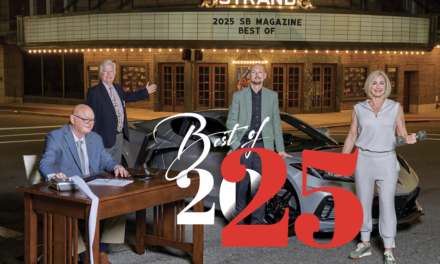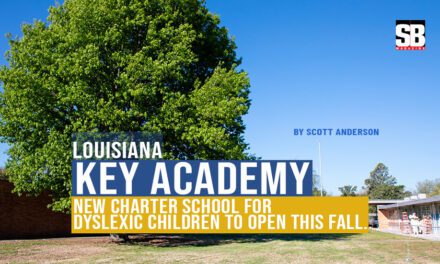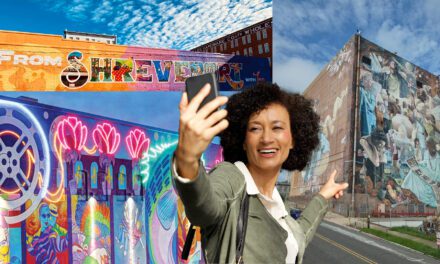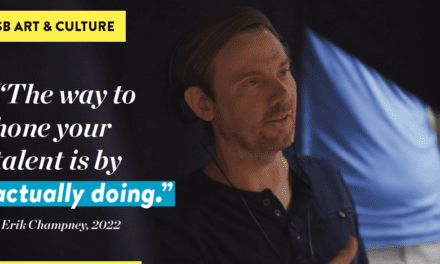
From SB Magazine: November 2023
Introduction by Seva May
Carnegie Hall beckons another talented Shreveporter. And this one has a resume longer than Line Avenue and the talent to back it up.
John-Henry Crawford was born into a family with a strong musical background. He was exposed to music from a young age and began playing the cello at age 5 in the Centenary Suzuki School. His musical education and training have been extensive, beginning with his acceptance into the prestigious Curtis Institute of Music at the age of 15 where he honed his skills and developed his unique style. He went on to complete a Master of Music at The Juilliard School and an Artist Diploma at the Manhattan School of Music. He has given concerts in 25 states as well as Brazil, Canada, Costa Rica, France, Ger- many, Mexico, and Switzerland.
Crawford won First Prize in the IX International Carolos Prieto Competition, was named Young Artist of the Year by the Classical Recording Foundation, and has played concerts at the Louvre in Paris, the Volkswagen Factory in Dresden, the Tchaikovsky Competition in Russia, and at the Dame Myra Hess series in Chicago. His dedication to his craft has earned him numerous accolades, including first prize winner of the Greenfield Competition where he made his solo debut with the Philadelphia Orchestra.
Crawford has also performed as a soloist with numerous orchestras in Pennsylvania, Illinois, New York, Texas, California, Tennessee, and Louisiana and has soloed with the Shreveport Symphony on four occasions. Crawford’s performances have received critical acclaim, with reviewers praising his technical skill, musicality, and emotional depth. Crawford commands a strong Instagram presence, having attracted tens of thousands of viewers to his project #The1000dayJourney, where for 3 years he filmed artistic cinematic videos daily from his practice and performances for over 50,000 followers (@cellocrawford) to give a glimpse into the working process of a musician.
His recordings and collaborations with other musicians have also garnered attention and accolades. His albums on Orchid Classics have accrued over 3 million streams. Corazón: The Music of Latin America (Editor’s choice in Gramophone Magazine), Dialogo, and his most recent release, Voice of Rachmaninoff all appeared on the Top 10 Classical Billboard chart.
Crawford performs on a rare European cello that is almost 200 years old, which was smuggled out of Austria by his grandfather before World War II. The instrument has a rich history and is a symbol of his grandfather’s experience as a Jewish physician living in Europe during a tumultuous time.
Crawford’s passion for his instrument and his talent as a cellist have earned him recognition as one of the most promising young musicians in the classical music world today. He credits his success to the inspiration and guidance of his mentors and peers, who have helped shape his musical life and career. Crawford’s dedication to excellence and innovation is evident in his ongoing commitment to musical education as he seeks new growth and development opportunities. Whether through collaborations with other musicians, performances in new venues, or ongoing study and practice, John-Henry Crawford is sure to continue making waves in the world of classical music.
He made his debut at Weill Recital Hall at Carnegie Hall on October 3, 2023, alongside pianist Victor Santiago Asunción, cementing his place as a rising star in the music industry.
We asked John-Henry to document his incredible experience of that evening, from walking onto the stage to the final note he played, with his hometown fans. Here is his story:
As the old adage goes, ask a New Yorker how to get to Carnegie Hall, and they might tell you something like “Go down Seventh Avenue until you hit 57th,” but ask a musician, and they are more likely to say, “Practice, practice, practice. Ever since I was a teenager, I had heard about Carnegie Hall and envisioned this kind of magical space where the world’s best performers made music, but I never imagined myself having the opportunity to do the same until more recent years.
My experience performing at Carnegie came about through the newly established American Recital Debut Award, which enables a young artist to debut in a concert hall of international renown and provides 3 years of concert management and artistic guidance. The appearance at Carnegie, however, was not the first stop in this journey. Over the past month, pianist Victor Santiago Asuncion and I performed the program nearly half a dozen times before finally performing in Carnegie’s Weill Recital Hall. This program was made up of works by primarily American composers such as Gershwin and Barber, but the second half featured a sonata by Rachmaninoff, who incidentally lived much of his life in America. Our first stop was Evanston, Illinois–where Victor is based– to rehearse and prepare all the music performances. We then performed in downtown Chicago for the Dame Myra Hess series, followed by several performances in the Chicago area for various libraries, retirement homes, and historic mansions before traveling to Memphis, Tennessee, for a chamber music series. Each performance allowed us to fine-tune the music and really get it in our bones so that the Carnegie performance would be smooth sailing. Additionally, Victor and I had recorded a full album of Rachmaninoff’s music titled Voice of Rachmaninoff on the London label Orchid Classics, which was released this past summer, so much of our preparation had been done months prior. As the big day approached, there were many things to do in addition to practicing: publicity, sending email invitations, printing programs, dry cleaning, instrument adjustments, bow re-hairs, studying what information about the composers I might share with the audience, and more. All these small but necessary things add up to provide a special experience for listeners– similar to how a restaurant must not only focus on the food but also the presentation and service.
While I always aim to do my best at every performance, certain occasions merit extra focus and preparation. This was definitely one of those concerts. The days and weeks leading up to an important performance like the one at Carnegie can imbue a feeling of tunnel vision, with the light at the end being the performance and no thought of what happens afterward. This feeling is familiar for musicians, as any competition or performance of significance can cause such a mindset. I become very routine-oriented in this lead-up, practicing my pieces in the same order, eating the same meals daily, and even going on walks with the same route. When pressures are high, the familiarity of repetition is comforting and allows me to focus on the important stuff, like making music to the highest level possible.
When the day finally arrives, Victor and I head over to the hall for a rehearsal session to run through the program, and while I have an idea of what to expect, I am struck by the beauty of the hall the second I walk in. Even hearing piano sounds from backstage, the sound is like that of a studio recording, and the closer I get to the stage door, the more it sparkles. Setting foot onto the stage fills me with awe and admiration for the acoustical and visual marvel of Weill Recital Hall. While I had heard many beautiful performances from the audience’s perspective, never had I stood on the stage. From the first note, I smile
as I hear the sound bounce back to me. There is an immediacy of sound and a shininess that one hears, thanks to the size and proportion of the hall but also the materials and design of the corners and curved ceilings. The gold-trimmed molding, crystal chandeliers, and blue satin draperies make it stunningly beautiful. A magnificent hall is not just for the listener but also enjoyable for the musician and inspires one to play to greater heights. The more time we spend going through the repertoire, the more we listen and learn from the hall, the way certain notes linger and other notes fade. After a thorough rehearsal, we break until the concert and rest up for a night of music-making.
The hour approaches, and I review some last-minute tough spots. My pre-concert routine varies but always includes some kind of sweet snack for a bump in energy. The 5-minute warning rings, and I rosin up my bow and tune the cello. Performing is as much a psychological feat as it is a physical one. Taking a few minutes to breathe deeply and have some quiet time really helps to clear my head and gets me focused on what is about to happen. I focus on the spirit of the music and how enjoyable I can make it for the audience. The stage door opens, and I see a sea of bodies all clapping as we make our way toward center stage. We bow, sit down, take a deep breath, and once the hall is silent, we begin. The first piece by Foss–Capriccio–is a kind of anthem to his new home of America after immigrating from Nazi-controlled Germany in 1937. A positive, upbeat, rhythmically driven work, his Capriccio embodies the optimism many feel when coming to this country to start a new life. Foss’s story hits close to home for me and my family because just a year after he left Nazi Germany, my grand- father, Dr. Robert Popper, fled Nazi-controlled Austria just seven weeks before Kristallnacht. The cello I play is one of several instruments he smuggled out of Austria into Switzerland for safekeeping. As I play, I think of my grandfather taking a long journey around Europe on trains and ships before later recovering them and traveling to the US to start a new life. The following piece is a Carnegie Hall premiere and a tribute to the victims of the attacks on 9/11, 2001, titled Seventh Avenue Kaddish. This solo cello piece by American composer David Sanford imagines a street musician near Ground Zero playing as buildings collapse and debris blinds. The music reflects the chaos of that moment and ends with a psalm-like lament. I am very honored to have the composer present at the premiere, and after a long silence, the audience applauds, and Mr. Sanford stands up in recognition of his work.
From the first note until the last, I feel as though I am immersed in a dream come true, especially in “Dreaming” by Amy Beach. The notes echo back to me with a golden sonority. Each piece becomes more comfortable as I become friends with the hall and the audience. In the heavenly melodies of Rachmaninoff through the stormy sections, it is as though I am one with the cello in a heroic effort to express Rachmaninoff’s voice and passion. As the recital goes on, I can slowly pick out some familiar faces in the crowd, and it feels like somewhat of a reunion. Many former classmates, fellow cellists, and family members are present, as well as mentors and teachers from the past. Seeing their faces and hearing their cheers in between pieces fills my heart with emotion and gratitude. While I didn’t learn this until after the concert, my first-ever cello teacher (from age five), Kristina Vaska-Haas, surprised me by making the trip from Potsdam, New York, to come to hear the concert.
To my surprise, after the last note of the Rachmaninoff Sonata, the audience jumps to their feet, one by one at first, and then all together. A young girl who has taken cello lessons with me runs to the edge of the stage with a huge bouquet of blue hydrangeas. It is an enormous honor to make music in such a wondrous space with so many important people from my life, past and present and gives me a newfound appreciation for what it really takes to get to Carnegie Hall. Hard work, of course, helps, but I’m grateful to God and the community of friends, teachers, family, and supporters who helped pave the way and nurture my music because the truth is, you can’t get to Carnegie Hall on your own. You need people, people to encourage you, people to teach you, and people to inspire you to be better.








